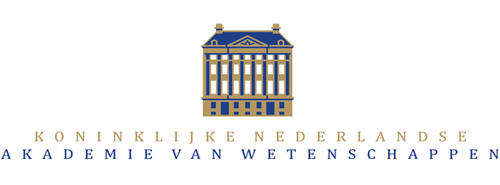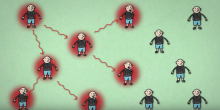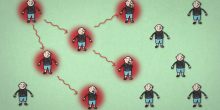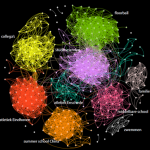On Tuesday 31st of May the KNAW organized the webinar "Verbonden tegen Covid-19 - Hoe netwerken pandemieën verspreiden en bestrijden" (Connected against Covid-19 - How networks spread and combat pandemics).
Almost 250 viewers followed the webinar, either via Zoom or via Youtube. The webinar was in Dutch and can be seen online on Youtube. My impression is that the automated translation in Youtube does a rather accurate translation, so don't hesitate to watch it. Below a review of the event.
Directly or indirectly networks played a crucial role during the Corona health crisis. During this online event four experts were invited to shed light on the relevance of networks in combating the epidemic, each one from a different point of view, namely from that of the exact sciences, medicine, communication and social sciences respectively. And to be fully honest, I really needed such a webinar; I have accumulated so much information during the last months and this webinar helped me give more structure to all this information. This webinar was a great moment to reflect and draw some conclusions.
The idea to organize this webinar came from Frank den Hollander, professor of mathematics at Leiden University and vice-president of the Domain Board Natural and Technical Sciences (Domeinbestuur van NTW). As mentioned earlier the program included four speakers, Piet Van Mieghem, Mirjam Kretzschmar, José van Dijck and Arnout van de Rijt.
Piet Van Mieghem – Spreading of viruses on networks
Piet Van Mieghem is professor at the Delft University of Technology with a chair in telecommunication networks and chairman of the section Network Architectures and Services (NAS) since 1998. His main research interests lie in the modelling and analysis of complex networks (such as infrastructural, biological, brain, social networks) and in new Internet-like architectures and algorithms for future communications networks.
During the webinar he talked about a very important duality in network science. Namely, the duality between functionality and structure. In case of the spreading of a virus, functionality refers to the characteristics of the virus itself, namely the time it takes for an individual to recover and the rate at which it spreads between individuals when there is a contact. On the other hand, structure refers to the underlying social network which shows how individuals come in contact. Important in order to analyze the structure of the underlying social network is the so-called spectral radius, denoted by  , a measure used from network scientists in order to infer information about the structure of a graph (the abstraction of a network). The Basic Reproduction Number for example can then be written as a product of two terms, the spectral radius and the strength of the virus, where the strength of a virus denoted by
, a measure used from network scientists in order to infer information about the structure of a graph (the abstraction of a network). The Basic Reproduction Number for example can then be written as a product of two terms, the spectral radius and the strength of the virus, where the strength of a virus denoted by  is defined as the fraction of the probability of an infection per contact divided by the recovery probability per individual.
is defined as the fraction of the probability of an infection per contact divided by the recovery probability per individual.

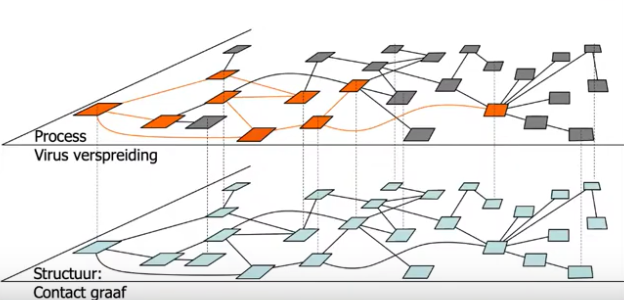
Duality between functionality and structure. Piet Van Mieghem - Verbonden tegen Covid-19
The message was thus that information about the structure of the contact network is essential, but how do you get information about this network? By making measurements! More about the practical issue of analyzing the contact network was given in the second talk.
Read also an interview with Professor Van Mieghem we did after the event.
Mirjam Kretzschmar – Contact tracing in networks
Professor Mirjam Kretzschmar is Chief Science Officer (CSO) of Mathematical Disease Modelling at the National Institute for Public Health and the Environment (RIVM). She is also an associate professor at the Julius Center for Health Sciences and Primary Care, University Medical Center Utrecht (UMC Utrecht). She primarily uses mathematical methods and models to obtain a new understanding of the spread of infectious diseases and the possible effects of interventions.
As discussed above in case of a virus spreading it is important to have information about the underlying contact network. But first, how do you actually define a contact? This has to do with the properties of the virus, but in general the principle is that there is a contact when two individuals stay sufficiently close to each other for a sufficiently long time for the virus to spread. In the news we heard very often that when someone got infected the authorities were trying to recover the contacts that this individual had made, this is one way to gather information concerning the contact network. Another method is by using a contact tracing application. The efficiency of such a mobile app as a contact tracing strategy was discussed. From the experiments done so far, based on simulations of mathematical models of contact tracing, it appears that such an app can be effective in lowering the so-called effective reproduction number R.

The results from simulations concerning the efficiency of contact tracing strategies. Kretzschmar et al; Lancet Public Health, In press

The blue bars concern the Contact Tracing Strategies (CT Strategies), Kretzschmar et al; Lancet Public Health, In press
José van Dijck – How (social) media can help fight a pandemic but also the spread of it
José van Dijck is a university professor of media and digital society at Utrecht University. Her research area is media studies and communication and her work focuses on social media, media technologies, social media, and digital culture.
In this third talk prof. van Dijck showed how social media played an active role in the spreading of (mis)information during the first three months of the Corona epidemic. In a nutshell, it appeared from her research that most of the activity on social media regarding the epidemic can be grouped in four narratives, the intelligent lockdown narrative, the medical narrative, the economical narrative and last but not least the smart exit narrative. The intelligent lockdown narrative for example concerns mostly the centrally organized campaigns in order to increase awareness regarding safety measures, the national institutes for public health relied a lot on social media which is shown by the fact that they hired so-called influencers to spread safety messages. Influencers are central players on social media with many followers who can reach a very large audience through their platforms.
Prof. van Dijck called social media a double edged sword, on one hand they help with increasing awareness and more people can participate in the public discussion. On the other hand, we should always keep in mind that they are commercial companies, who aim at making profit and many times also allow the spreading of misinformation and polarization.
Read also an interview with Professor van Dijck we did after the event.
Arnout van de Rijt – Does social behavior spread as a virus?
Arnout van de Rijt is Professor of Sociology and Designated Chair for the UU strategic theme Institutions for Open Societies. Van de Rijt leads the research line Computational Sociology at the Department of Sociology. His research focuses on the emergence of social structure.
In this last talk the speaker focused on how people change their behavior in a time of an epidemic. In case of change of behavior local communities affect people’s behavior far more than the so-called influencers. A change in behavior occurs if a majority of someone’s friends and contacts changes their behavior. Hence strongly connected clusters of people play a significant role concerning behavior. In strongly connected clusters members tend to adapt the behavior of the majority of the members of the group more easily than someone outside of the group would do. For example someone who has many friends who got infected from the virus is more inclined to change behavior and adopt stricter rules. If you thus compare spreading of behavior and spreading of a virus or information, behavior has a heavily local character while for spreading of information or a virus the superspreaders play a more influential role.
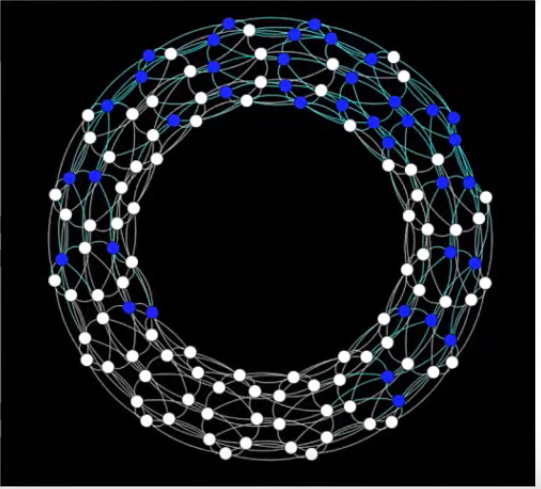
Centola D. (2010), The spread of behavior in a social network experiment, Science, 329. Verbonden tegen Covid-1.
To conclude, if you also feel you want to give more structure on the information accumulated during the last months then I strongly recommend to watch this webinar.

